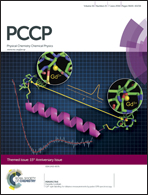ωB97X-V: A 10-parameter, range-separated hybrid, generalized gradient approximation density functional with nonlocal correlation, designed by a survival-of-the-fittest strategy
Abstract
A 10-parameter, range-separated hybrid (RSH), generalized gradient approximation (GGA) density functional with nonlocal correlation (VV10) is presented. Instead of truncating the B97-type power series inhomogeneity correction factors (ICF) for the exchange, same-spin correlation, and opposite-spin correlation functionals uniformly, all 16 383 combinations of the linear parameters up to fourth order (m = 4) are considered. These functionals are individually fit to a training set and the resulting parameters are validated on a primary test set in order to identify the 3 optimal ICF expansions. Through this procedure, it is discovered that the functional that performs best on the training and primary test sets has 7 linear parameters, with 3 additional nonlinear parameters from range-separation and nonlocal correlation. The resulting density functional, ωB97X-V, is further assessed on a secondary test set, the parallel-displaced coronene dimer, as well as several geometry datasets. Furthermore, the basis set dependence and integration grid sensitivity of ωB97X-V are analyzed and documented in order to facilitate the use of the functional.

- This article is part of the themed collection: PCCP’s 15th anniversary

 Please wait while we load your content...
Please wait while we load your content...